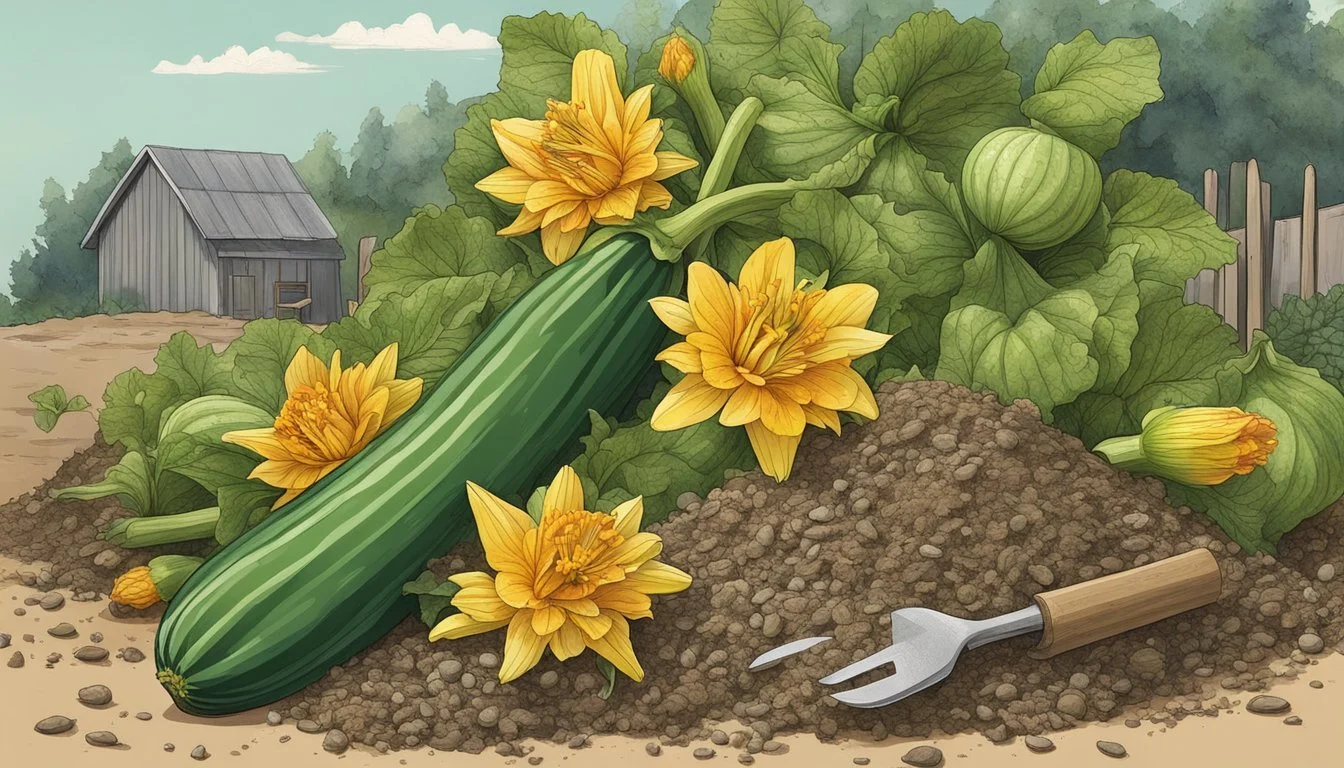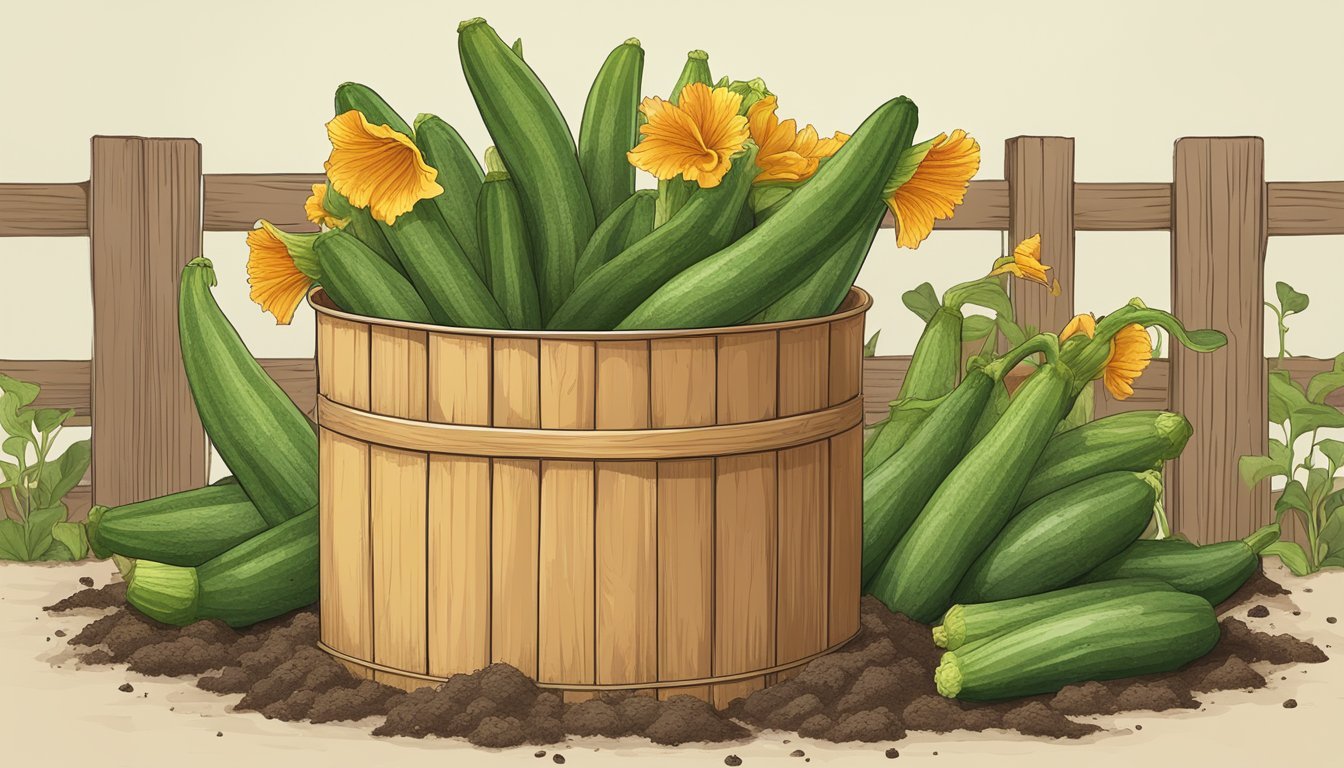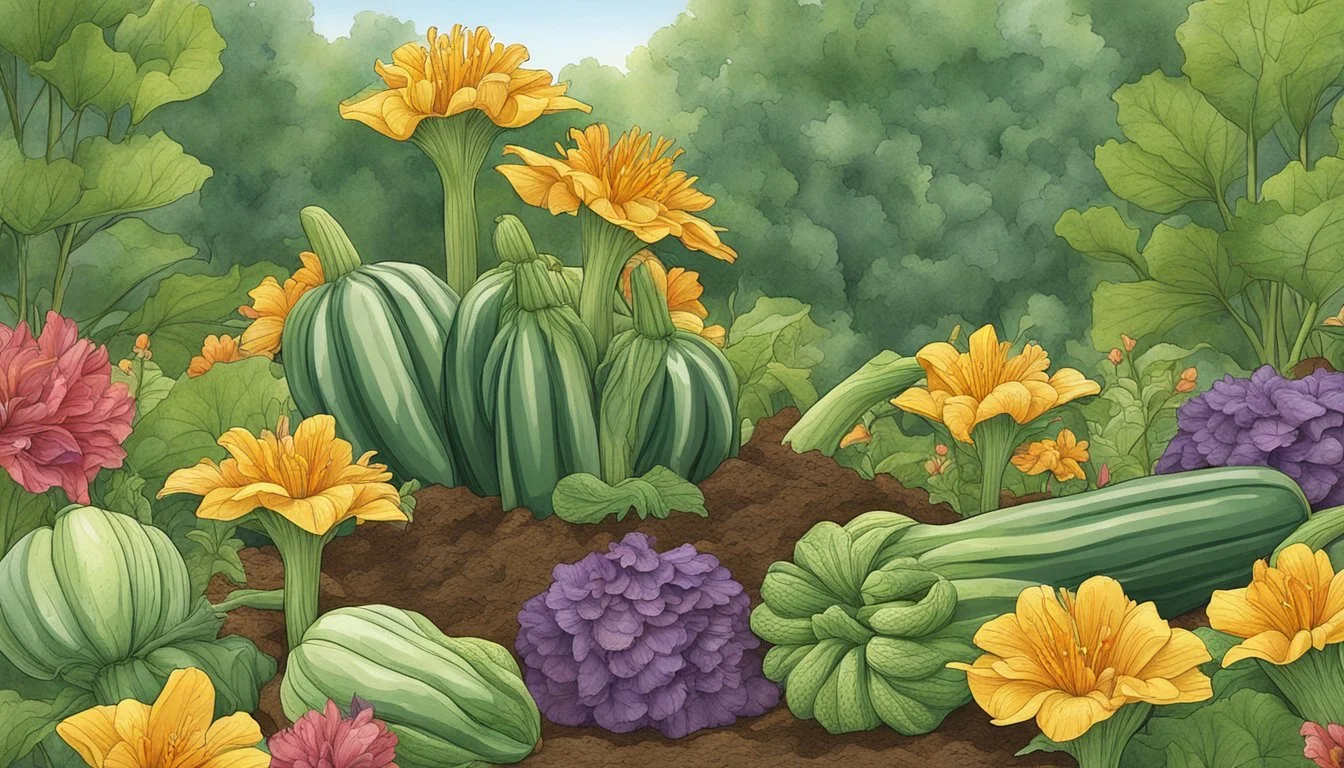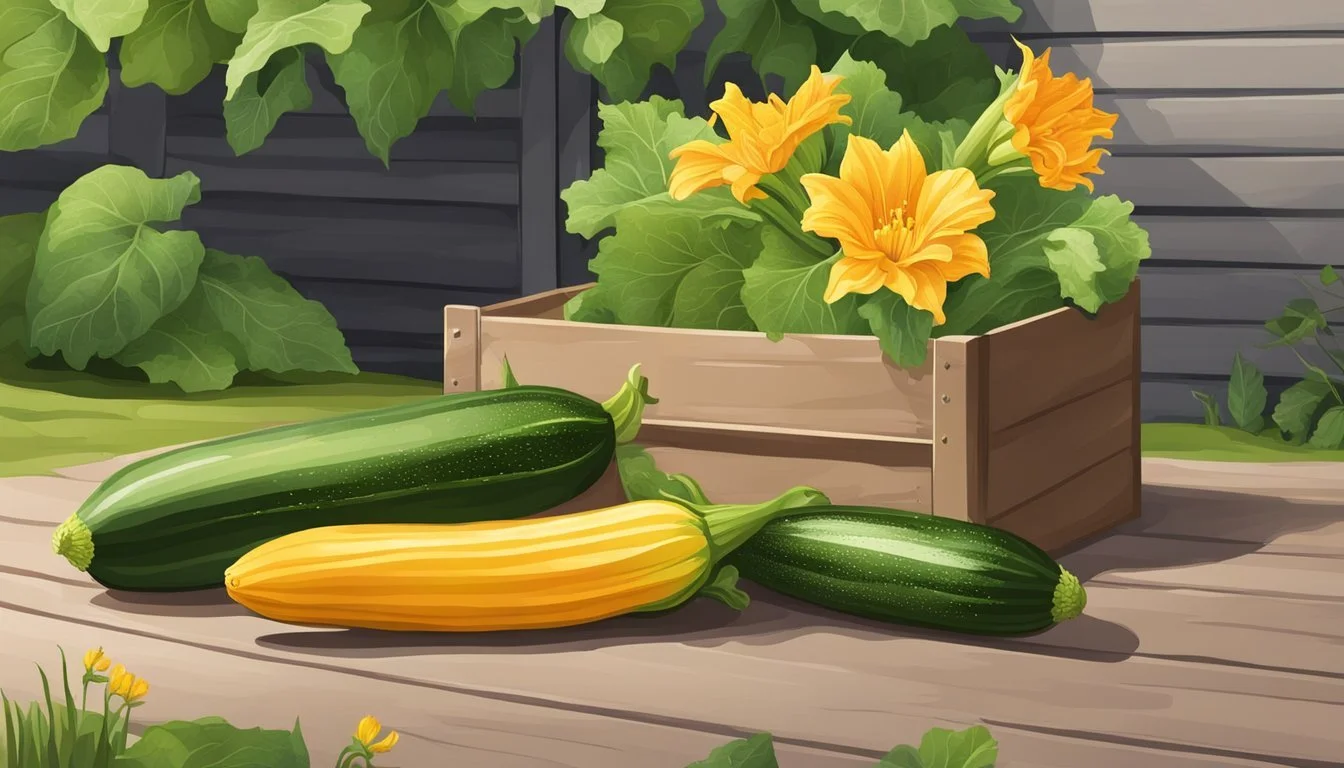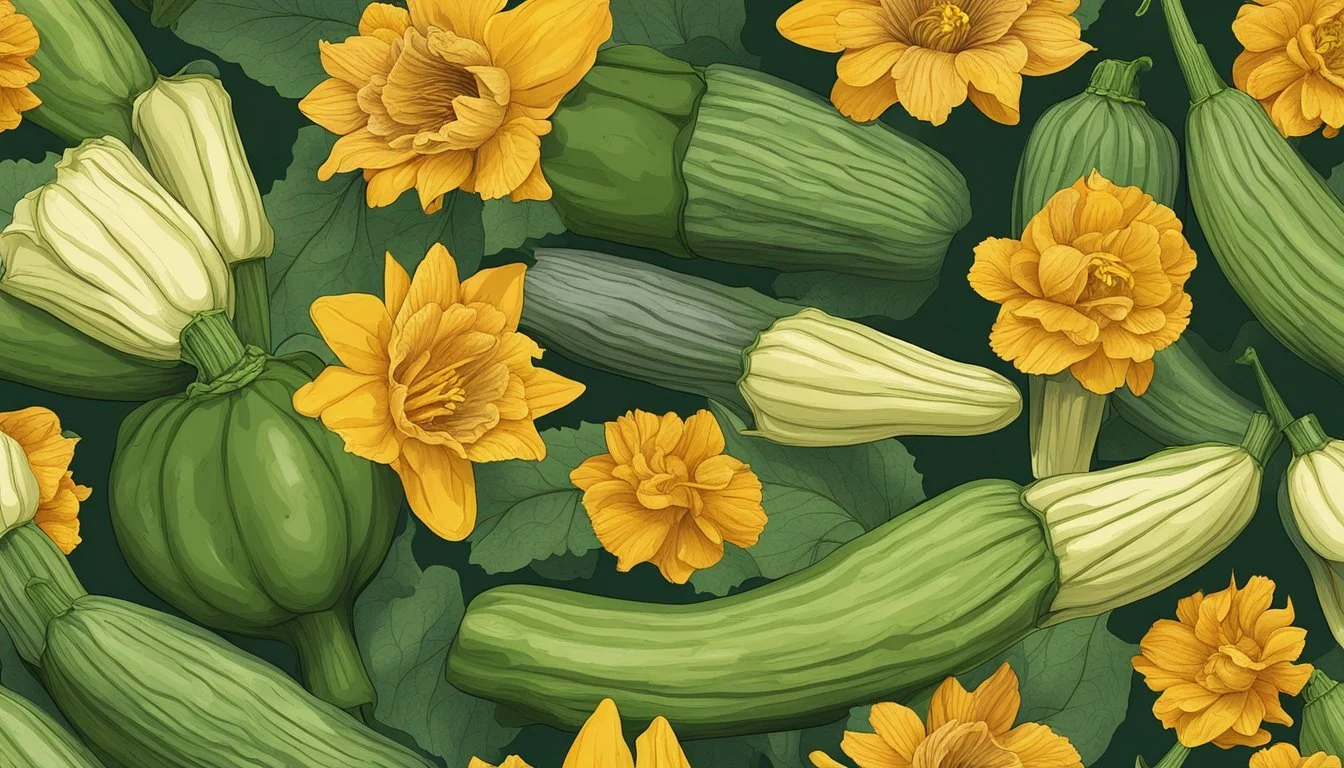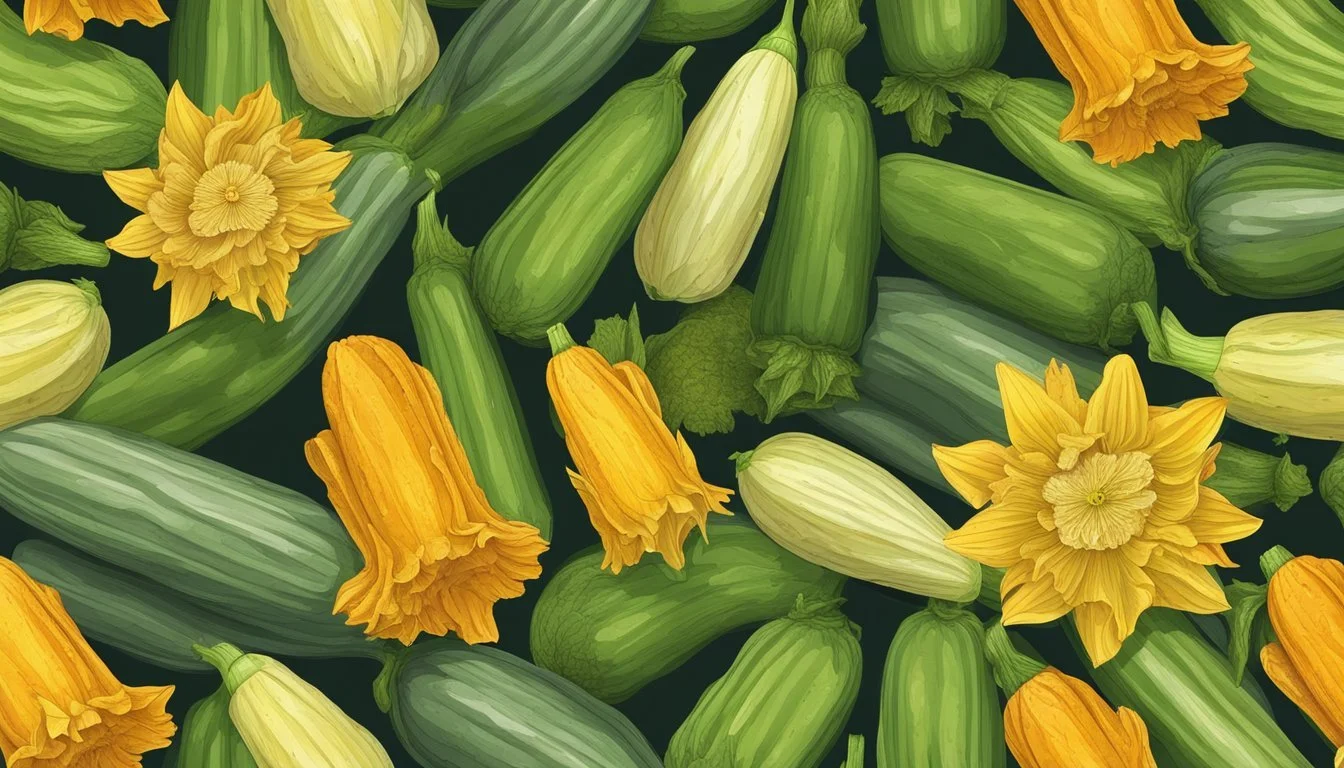Can You Compost Zucchini Flowers?
Insights on Garden Waste Recycling
Zucchini (What wine goes well with zucchini?) flowers, like the rest of the zucchini plant, are compostable. They consist of organic matter that readily breaks down within a composting system. As a part of the compost pile, zucchini flowers contribute to the nitrogen content, which is essential for the composting process. They are categorized as 'green' materials in composting parlance, providing an important nitrogen source that balances with 'brown' materials, which are high in carbon.
When adding zucchini flowers to a compost pile, it’s beneficial to ensure that they are free of pesticides and disease to prevent any potential negative impacts on the compost's quality. The flowers should be mixed thoroughly with other compost materials to promote even decomposition. The presence of zucchini flowers in compost can ultimately enhance the nutrient profile of the finished product, which can be used to enrich garden soil, aiding in the growth of healthy plants.
Understanding Compost and Its Benefits
Compost is a rich, earthy material that results from the natural decomposition of organic matter. When organic waste, such as food scraps and plant material, is broken down by microorganisms, compost is created. This process recycles nutrients and returns them to the soil, thereby enhancing soil health and fertility.
The inclusion of organic materials like zucchini flowers into a compost pile contributes nutrients to the resulting compost. These nutrients are vital for plant growth and improve the overall structure of the soil. The organic matter acts as a natural conditioner, promoting water retention and aeration, which are essential for robust plant roots.
Composting also serves the environment by reducing the amount of waste that ends up in landfills, thereby curtailing methane emissions—a potent greenhouse gas. Additionally, the practice reduces the need for chemical fertilizers, which can be harmful to both the environment and human health.
The Benefits of Compost to Soil and Environment:
Improves soil structure: Compost increases the soil's ability to absorb and retain water.
Enhances fertility: It provides essential nutrients that plants need to grow.
Encourages healthy root systems: Healthy soils make for strong plant roots.
Reduces landfill waste: Keeps organic waste out of landfills and reduces greenhouse gas emissions.
Minimizes chemical use: Lessens the dependency on chemical fertilizers, promoting a safer environment.
By turning organic materials like zucchini flowers into compost, gardeners and farmers can rejuvenate their soil while contributing to a healthier ecosystem.
Pre-Composting Considerations
Before adding zucchini flowers to a compost pile, it’s essential to understand what materials are suitable for composting and how to optimize the composting conditions for efficient decomposition. These two critical aspects ensure the creation of a rich compost that enhances soil health and supports garden vitality.
What Can Be Composted
Zucchini flowers are an excellent source of nitrogen, which is a crucial component for a balanced compost pile. They fall under the category of green organic materials, which also include:
Vegetable and fruit scraps
Coffee grounds and filters
Fresh grass clippings
Manure from herbivores
These materials provide the necessary nitrogen to feed the microorganisms that break down the waste. To maintain a healthy compost, however, it's important to balance greens with carbon-rich "brown" materials like:
Dried leaves
Straw
Cardboard
Woody prunings
Egg cartons
A general guide for an effective compost mix is to use roughly one-part greens to three parts browns.
Optimizing Your Compost Conditions
Proper aeration and moisture are the pillars of a thriving compost pile. The following conditions should be monitored and managed:
Temperature: A compost pile should maintain an internal temperature between 135°F and 160°F to support the activity of thermophilic bacteria crucial for breaking down organic material.
Moisture: The pile should be as moist as a wrung-out sponge. This level supports microorganism activity without causing anaerobic conditions.
Aeration: Regularly turning the compost pile ensures adequate airflow, preventing anaerobic conditions and smelling, and it stimulates rapid bacteria growth.
Balance: Maintaining the right balance of carbon and nitrogen, along with aeration and moisture, accelerates decomposing and produces high-quality compost that improves water retention and soil structure in the garden.
Composting Zucchini Flowers
Composting zucchini flowers is an effective way to recycle these plant parts into nutrient-rich soil after they've served their purpose. They contribute to the 'green' component of compost, providing nitrogen that aids in the decomposition process.
When to Compost Zucchini Flowers
Zucchini flowers are typically abundant during the summer squash season and can be composted once they begin to wilt or after they have been used for culinary purposes. It's important to ensure that the flowers added to the compost bin are free from pests and diseases to prevent the spread of unwanted problems within the compost pile.
Preparation of Zucchini Flowers for Composting
Before adding zucchini flowers to a compost heap, chop the flowers, leaves, and stems into smaller pieces to accelerate decomposition. This also helps maintain the necessary moisture levels in the compost pile. Zucchini flowers, along with other foliage from the squash plant, can be mixed with 'brown' compost materials such as dried leaves or straw to maintain a balanced carbon-to-nitrogen ratio.
Composting Process and Techniques
Effective composting involves understanding what to compost, how to layer organic materials, and the necessary maintenance to optimize the decomposition process. By properly managing these elements, one can transform waste into nutrient-rich mulch that benefits garden plants.
Materials to Include in Your Compost
A successful compost bin should contain both green and brown materials. Green materials are nitrogen-rich and include vegetable scraps like zucchini flowers, grass clippings, and coffee grounds. Brown materials provide carbon and include leaves, shredded paper, and straw. A balance between these two sets of materials is critical in composting, as it creates an environment conducive for decomposition.
Green Materials
Vegetable scraps (e.g., zucchini flowers)
Grass clippings
Coffee grounds
Fresh manure
Brown Materials
Leaves
Shredded paper
Straw
Wood chips
Layering Your Compost
To optimize the decomposition process, one should strategically layer their compost bin. Start with a base layer of coarse materials, such as sticks or straw, to enhance aeration and drainage. Alternate layers of green materials like food scraps with brown materials such as leaves. Regularly adding and mixing these layers will maintain the balance necessary for efficient composting.
Base layer of coarse materials (sticks, straw)
Add a layer of green materials
Add a layer of brown materials
Repeat layering and mix occasionally
Maintaining Your Compost
Maintenance is key for turning organic waste into rich compost. The compost heap should remain moist but not waterlogged; it requires turning every few weeks to introduce air and aid the microorganisms in breaking down material. In colder climates or seasons, insulation with materials such as bales of straw may be necessary to retain heat within the compost bin and continue the decomposition process.
Maintain moisture level (like a wrung-out sponge)
Turn compost every few weeks for aeration
Insulate in cold conditions to retain heat
Troubleshooting Common Composting Issues
When composting zucchini flowers or any organic material, certain challenges such as pests, excessive moisture, unpleasant odors, and suboptimal decomposition rates can arise. Addressing these effectively ensures a healthy composting process and output.
Dealing With Pests and Pathogens
Pests such as flies and rodents can be attracted to compost bins if not managed properly. To combat this:
Establish barriers: Use wire mesh or physical barriers to deter pests.
Maintain a balance: Ensure a good carbon to nitrogen ratio to avoid attracting pests with strong odors.
Pathogens can also infiltrate the compost pile, potentially harming the end product. It's important to:
Avoid diseased plants: Do not compost zucchini flowers or plants with visible signs of disease.
Heat management: Ensure the pile reaches sufficient temperatures to kill harmful bacteria.
Managing Moisture and Odor
The moisture level in a compost pile should be akin to a wrung-out sponge. To handle moisture and odor:
Regular turning: This aerates the pile and evens out moisture levels.
Correct balance: Add more "browns" to absorb excess moisture if the compost is too wet and emits an ammonia-like odor.
Beneficial microorganisms need the right environment to thrive, which includes adequate moisture. Therefore, irregular watering may be required.
Ensuring Proper Decomposition
For effective decomposition:
Aeration: Regularly turn the compost to introduce oxygen, promoting aerobic bacteria activity for proper decomposition.
Size matters: Chop or shred zucchini flowers to speed up the breakdown process.
Monitor temperature: Keep the compost between 135°F and 160°F to facilitate the activity of beneficial microorganisms.
An optimal composting setup minimizes the need for chemical fertilizers, providing an environmentally friendly source of fertilizer rich in beneficial bacteria.
Benefits of Composting Zucchini Flowers in Your Garden
Composting zucchini flowers contributes to creating a nutrient-rich soil while embodying sustainable waste management practices within one's garden ecosystem.
Improving Soil Structure and Nutrient Content
Composting zucchini flowers benefits the soil structure by introducing organic matter that enhances water retention and aeration. The decomposed matter from zucchini flowers enriches the soil with nutrients essential for plant growth. A garden that incorporates composted zucchini flowers is likely to exhibit an improved soil structure that can support robust plant life. The end result is a garden with soil that is both fertile and structurally sound, encouraging stronger root systems and healthier plants.
Nutrients added to the soil from composted zucchini flowers:
Nitrogen
Potassium
Phosphorus
Reducing Waste and Environmental Impact
By composting zucchini flowers, gardeners can reduce their contribution to landfills, thereby diminishing their environmental footprint. This practice not only limits the amount of organic waste but also transforms it into a valuable resource for the garden. Composting helps to close the loop of the food cycle in the garden, turning waste into a viable product that contributes to soil health and, consequently, plant vitality.
Environmental benefits of composting zucchini flowers:
Reduces waste: Limits organic matter going to landfills
Lowers emissions: Decreases methane production from decomposing organic matter in landfills
Promotes sustainability: Encourages a cycle of growth and renewal in the garden ecosystem
Compost Use in Garden
Gardeners often turn to compost to enrich their garden soil and provide plants with essential nutrients. By understanding how to effectively use compost in the garden, one can enhance plant growth and soil structure.
Incorporating Compost into Garden Soil
Incorporating compost into garden soil is a foundational practice in sustainable gardening. The rich organic material in compost improves soil texture, aids in water retention, and introduces beneficial microorganisms. Before planting seeds or transplanting young plants, gardeners should mix compost into the top few inches of the soil. This enrichment technique is especially beneficial to vegetable gardens, where zucchini flowers and other nutrient-hungry plants thrive.
Using Compost as Mulch or Fertilizer
Compost can serve double duty as both mulch and a natural fertilizer:
As mulch: Spread a layer of compost around plants to conserve moisture, regulate soil temperature, and reduce weed growth. The organic material gradually breaks down, delivering nutrients to the roots of plants including ornamental flowers and vegetable patch staples like zucchini.
As fertilizer: Compost, rich in nitrogen and phosphorus, can be used to side-dress plants during the growing season. Apply compost near the stem of the plants where it can deliver essential nutrients directly to the roots without the risk of burning them, which is possible with synthetic fertilizers.
Compost application is most effective in a sunny location where it can aid in water conservation, thereby reducing the frequency of watering necessary for maintaining a thriving garden.
Seasonal Considerations for Composting
When composting zucchini flowers or other summer squash plant matter, one must consider the local climate conditions, as they drastically influence the outcome of the composting process. Factors such as temperature, moisture levels, and seasonal changes can play significant roles in composting efficiency and timing.
Composting in Different Climates
Temperature: In warmer climates, composting can proceed more quickly due to higher ambient temperatures, which enhance microbial activity. Gardeners should aim for a compost pile temperature between 130°F to 150°F (55°C to 65°C) for optimal decomposition. However, during peak summer heat, it's essential to ensure the pile does not dry out, which can slow the process and harm the beneficial microorganisms.
Table: Temperature Effects on Compost Piles
Temperature Range Effect on Composting Below 50°F (10°C) Slows down microbial activity 50°F - 113°F (10°C - 45°C) Ideal for mesophilic microbes 113°F - 160°F (45°C - 71°C) Ideal for thermophilic microbes Above 160°F (71°C) Might kill beneficial bacteria
Moisture Levels: Composting in different climates means adjusting moisture levels accordingly. In arid regions, compost may require regular watering to maintain the necessary moisture. Conversely, in very wet climates, compost piles may need cover to prevent becoming waterlogged. The moisture content of a healthy compost pile should be similar to a wrung-out sponge.
List: Tips for Maintaining Moisture Levels
In dry climates, water the pile as needed to maintain moisture.
In humid climates, cover the pile to protect from excess rain.
No matter the climate, the pile should be moist but not soggy.
Season: The season influences the availability of compostable materials. Post-harvest in fall, there's an abundance of leaves and leftover plants from the vegetable garden, including zucchini flowers and squash, which can enrich the garden soil. In spring and summer, fresh green waste from garden pruning and thinning can be added to piles. One should place the compost bin or pile in a sunny location to gain the benefits of sunlight, which can help maintain the pile's temperature.
Checklist: Seasonal Actions for Optimal Composting
Spring/Summer: Add fresh green waste and turn the pile regularly.
Fall/Winter: Incorporate fallen leaves and harvested plant matter.
Year-Round: Monitor and adjust for temperature and moisture levels.
Advanced Composting Techniques
When composting zucchini flowers, gardeners can adopt advanced techniques that optimize the breakdown process and enrich the final compost product. These methods introduce specialized processes or environments that benefit the decomposing organic matter.
Vermicomposting
Vermicomposting involves the use of worms, typically red wigglers (Eisenia fetida), to break down organic waste. The digestive process of these worms transforms zucchini flowers and other organic materials into rich, granular castings. For optimal vermicomposting:
Maintain a bin with a balance of moisture and airflow to support worm activity.
Combine zucchini flowers with a mix of "browns" like shredded paper or dry leaves to ensure a well-balanced environment for the microorganisms.
Bokashi Composting
Bokashi composting is an anaerobic process that ferments organic waste before it's traditionally composted. It features the use of an inoculant, typically a mix of bacteria and yeast that promotes fermentation. For effective Bokashi composting:
Chop zucchini flowers into small pieces to enhance fermentation.
Seal the flowers in a Bokashi bucket with the inoculant and periodically drain the liquid to prevent putrefaction.
Compost Tea
Compost tea is a nutrient-rich liquid derived from compost that provides a quick nutrient boost. It's created by steeping finished compost in water and agitating it to increase oxygen, which helps beneficial microbes thrive. Here are key steps to make compost tea:
Fill a brewing bag with cured compost rich in microbes, including decomposed zucchini flowers.
Suspend the bag in water, ensuring aeration to promote the growth of bacteria and fungi.
After brewing, apply the tea to plants for a surge of beneficial microorganisms.
Incorporating Other Kitchen and Yard Waste
When adding zucchini flowers to the compost, it's beneficial to mix them with other kitchen and yard waste to create a balanced compost pile. Including a variety of materials ensures proper breakdown and nutrient diversity.
Composting Vegetable Scraps
Vegetable scraps are an excellent source of nitrogen and add necessary moisture to the compost pile. Items such as pea pods, bean shells, and corn husks should be chopped into small pieces to speed up decomposition. Mix these green materials evenly with carbon-rich brown materials like dry leaves.
Do:
Add chopped vegetable scraps
Mix with brown materials for balance
Don't:
Include diseased or insect-infested plants
Add oily or cooked food waste
Composting Grass Clippings and Leaves
Fresh grass clippings and leaves serve as excellent green and brown materials, respectively. Grass clippings should be spread thinly to prevent matting and promote quicker breakdown. Alternating layers of grass clippings with leaves creates an effective mulch that can regulate moisture and temperature within the pile.
Do:
Layer grass clippings with leaves
Ensure good airflow to avoid odor and pests
Don't:
Compost treated lawn clippings
Let wet grass clippings clump together
Dealing With Larger Yard Waste
Larger yard waste such as twigs and wood chips adds structure to your compost and helps aerate the pile. Break down larger pieces to increase the surface area for microorganisms to work on. Consider using a shredder or chipper for size reduction. These carbon-rich materials should be balanced with green waste to maintain the decomposition process.
Do:
Shred or chip larger waste for faster breakdown
Balance with green materials like vegetable plants
Don't:
Include large branches that take too long to decompose
Overload the pile with too much wood material
Attracting Beneficial Wildlife with Compost
Composting, including the addition of organic zucchini flowers to the pile, contributes to a healthier garden ecosystem by attracting and supporting diverse wildlife. Here's how compost serves as a crucial element in creating a vibrant habitat for various beneficial species.
Creating a Habitat for Pollinators
Compost-rich soil inherently provides nutrients that facilitate the growth of a diverse array of plants, which in turn attract pollinators such as bees, butterflies, and hummingbirds. These creatures rely on flowers for nectar and pollen, and in doing so, they play a crucial role in the garden's pollination process. A garden with a healthy compost system supports a flourishing environment where pollinators can thrive and contribute to the growth of fruit and vegetable plants.
Inviting Decomposers and Soil Builders
The breakdown of organic material such as zucchini flowers in compost piles creates a perfect environment for decomposers like earthworms and myriad microorganisms. These organisms are vital for converting organic waste into rich humus, improving soil structure, and increasing its capacity to hold nutrients and water. The presence of beneficial bacteria and other decomposers in compost enriches the soil and sustains the health and balance of the garden ecosystem, ultimately encouraging a more organic and self-sustaining environment.
Avoiding Common Mistakes in Composting
Successful composting involves a fine balance between different materials and conditions to ensure efficient decomposition. Managing the mix of green (nitrogen-rich) and brown (carbon-rich) matter, particle size, and overall health of the compost are critical for maintaining soil health without attracting pests or diseases.
Balancing Green and Brown Materials
Greens are rich in nitrogen, essential for the growth of composting bacteria. These include kitchen scraps like zucchini flowers and fruit peels. Browns, providing carbon, consist of items like dry leaves and branches. A common ratio for optimal decomposition is approximately 4 parts browns to 1 part greens. To maintain this balance:
Add 4 times as much brown materials as green materials.
Mix regularly to prevent nitrogen overload, which can smell unpleasant.
Ensuring Proper Particle Size and Diversity
Particle size in compost influences airflow and the rate of decomposition. Smaller pieces decompose faster due to increased surface area for bacteria to act on. To ensure diversity and proper particle size:
Chop or shred large organic debris into smaller pieces before adding it to the pile.
Aim for a mixture of sizes to maintain adequate airflow, avoiding compaction which can lead to anaerobic conditions and odor.
Monitoring Compost Health
A healthy compost pile needs to avoid extremes in moisture and temperature that can slow decomposition or kill beneficial microbes. Monitoring compost health includes:
Ensuring consistent moisture, like a wrung-out sponge, to support microbial activity without creating waterlogged conditions.
Turning the pile regularly to distribute air and even out temperature fluctuations, promoting aerobic conditions and preventing material from becoming too cold or too hot.
Watching for signs of disease, pests, and weeds. Proper compost maintenance can prevent the spread of unwanted elements into your garden when the compost is used.
Legal and Community Considerations
When composting zucchini flowers, individuals must be aware of their local composting regulations and the availability of community composting programs which can influence and support their composting practices.
Local Regulations on Composting
Local authorities may have specific rules concerning the composting process, including materials allowed and restrictions on composting locations. Residents should check with their city or county waste management department to ensure compliance. Regulations could impact:
Accepted compost materials: Certain organic materials may not be allowed in backyard compost bins.
Composting site regulations: There might be rules regarding the proximity of compost bins to property lines or water sources.
Composting methods: Some areas may mandate specific composting methods to control odors and pests.
Engaging with Community Composting Programs
Many communities offer programs that facilitate composting for those who might not have the space or resources to compost at home. Engagement with these programs often includes:
Drop-off sites: Locations where you can take your compostable materials, including zucchini flowers.
Educational resources: Guidance on what can be composted and how to prepare materials for composting.
Volunteering opportunities: Communities might welcome residents to assist with the composting process, offering a hands-on experience.

